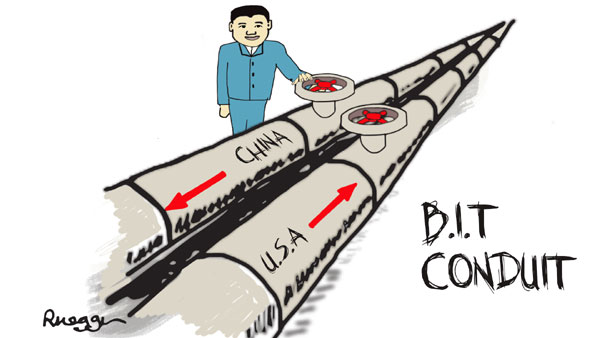Trump’s deficit crusade overshadows Xi’s investment treaty pitch

Bloomberg | 19 April 2017
Trump’s deficit crusade overshadows Xi’s investment treaty pitch
China’s President Xi Jinping and his U.S. counterpart Donald Trump appear to be operating on vastly different time scales when it comes to bilateral economic relations.
Team Trump is looking for "tangible results" to reduce the trade deficit "quite noticeably" within 100 days of the Mar-a-Lago meeting. Having declined to label China a currency manipulator on Friday, there’s pressure on the U.S. president to show rustbelt voters that all that China bashing was more than just campaign rhetoric.
Xi is pushing to revive talks for a Bilateral Investment Treaty among other priorities such as cooperation in infrastructure construction and energy, according to the official Xinhua News Agency. While Xi doesn’t need to worry about placating voters, he does have internal party constituencies to win over, and an investment deal could be just the thing to accelerate economic reforms.
“The two nations seem to be moving at different paces,” said Song Hong, a senior fellow at the Chinese Academy of Social Sciences, a government-backed think tank. “Trump wants to have something that can be delivered very quickly, whereas China hopes to push forward the BIT, which will set the framework in years to come.”
China proposed the "100-day" plan to lock in an "early harvest" before a planned visit from Trump, China’s ambassador to the U.S. Cui Tiankai told the state-run CGTN English news channel on April 13. The intention was to show commitment to "a healthy and stronger economic relationship" and focus initially on the "easy issues while making continued efforts on the harder issues," he said.
That suggests China is prepared to go along with Trump’s focus to quickly address a deficit that favored the Asian exporting powerhouse by $347 billion last year. Yet it’s the BIT that could prove more significant if agreement on that can ever be reached, by driving the next phase of China’s economic development and forcing long-cosseted services industries to face competition from American companies.
Negotiations on the Bilateral Investment Treaty have been going on for almost a decade. A key sticking point has been the so-called negative list of economic sectors that would be excluded, while mutual access to the rest would be advanced.
Without addressing the lack of market access American companies face in China and leveling the playing field, the deficit issue cannot be solved, said William Zarit, chairman of the American Chamber of Commerce in China.
"In order to have a meaningful Bilateral Investment Treaty, we really need to make a lot of progress on the negative list," Zarit said. "That is really in China’s hands."
Another obstacle facing the stalled investment talks is that the opening of China’s markets to U.S. businesses doesn’t seem to be a priority for Trump’s team right now. “His supporters will view the agreement as one that will encourage large U.S. companies to move U.S. jobs to China,” said Wendy Cutler, former acting deputy U.S. trade representative.
External Force
For China, the BIT could be a game changer, driving reforms in the same way that occurred after entry to the World Trade Organization in 2001, which forced manufacturers to improve the quality of their products as they gobbled up global market share. “It would provide an external force to help open and reform China’s economy,” Cutler said.
Chinese leaders in 2013 charted an ambitious plan to give market forces a greater say in the economy. While there has been progress in some areas such as interest-rate liberalization, movement has been slower in others such as reducing the role of bloated state-owned companies.
“Sometimes we need some forces from outside to push us to reform,” said Jiang Shan, former general director of Americas and Oceanic affairs at the Ministry of Commerce, who was involved in earlier rounds of BIT negotiations with the U.S.
U.S. First
While the European Union has long been negotiating a BIT with China, the U.S. may come first and get a better deal, Natixis SA economists led by Alicia Garcia Herrero wrote in a recent note.
The concessions required from Beijing to secure a BIT between the world’s two largest economies will be painful but worthwhile, said Tu Xinquan, dean of the China Institute for WTO Studies at the University of International Business and Economics in Beijing.
“Only the U.S. has the power to force China to make systemic concessions,” Tu said.
While Trump is seeking immediate progress, his concerns about the trade deficit can only be addressed through long-term policies such as those envisaged in the BIT, said Daniel Morris, senior investment strategist at BNP Paribas Investment Partners in London.
A Treasury Department report on Friday said China’s trade surplus “underscores the need for further opening of the Chinese economy to American goods and services” and quicker reforms to boost household consumption. While stopping short of labeling China a currency manipulator, it urged China to allow the yuan to rise with market forces and embrace more trade.
The BIT “could be a natural vehicle for a ‘grand bargain’ that goes far in resolving several long-standing areas of tension in the economic and political relationship,” said Nate Olson, director of the Trade in the 21st Century Program at the Stimson Center in Washington.
See article on original page for hyperlinks and notes





